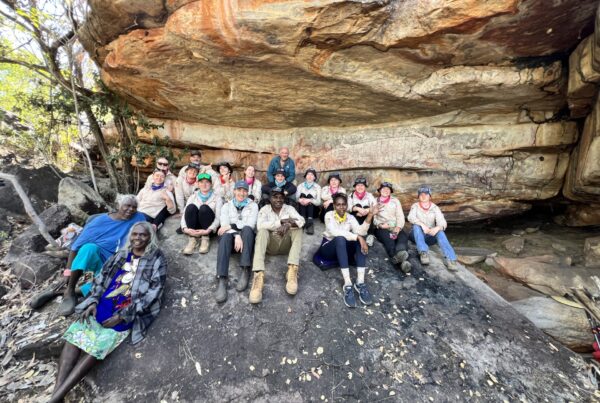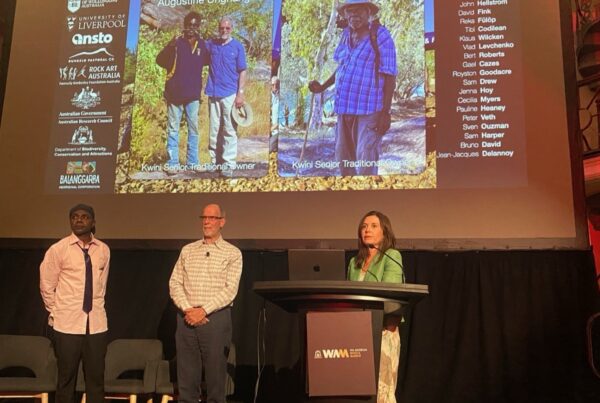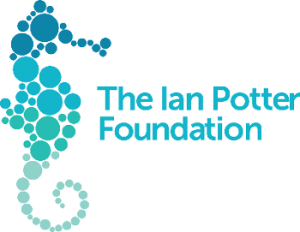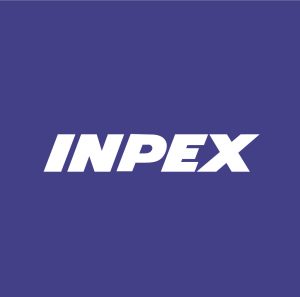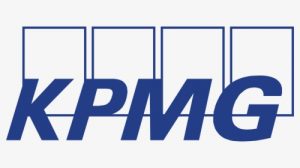Welcome to Rock Art Australia’s Summer E-News
It is a great pleasure to write this introduction to the Summer E-News as the new CEO of Rock Art Australia. It has been a busy and exciting 3 months in the role. I had the privilege of working with the RAA team to deliver and attend several lectures, publish and launch a book and join the annual research workshop. Through these events I met, listened, and learnt from researchers, generous donors, corporate partners, and supporters. I also travelled to the Kimberley and met with Aboriginal community members with my colleague Liz Vaughan. It was important to take the time to listen, learn and discuss the communities’ rock art research interests and priorities. This listening and learning has allowed me to begin to understand RAA’s purpose and impact, and I look forward to developing relationships and working in partnership to deliver beneficial outcomes.
The key takeaway for me over the last 3 months is the vast amount of prolific, considered, and diverse research performed over several decades to uncover stories about our Australian past. Researchers and Aboriginal community members have been working together to share knowledge and document, analyse, contextualise, and preserve rock art. This research has explored changes to the landscape due to climate change and land erosion and how these changes have influenced human migration, habitation, and the creation of rock art. Furthermore, the research teams have characterised and analysed pigments and used scientific dating techniques to further reveal the age, cultural production, processes, stories, and influences of rock art. I look forward to keeping you informed about the latest research developments, partnerships, and outcomes and meeting you at events and gatherings in 2024, which are designed to share some of these illuminating stories.
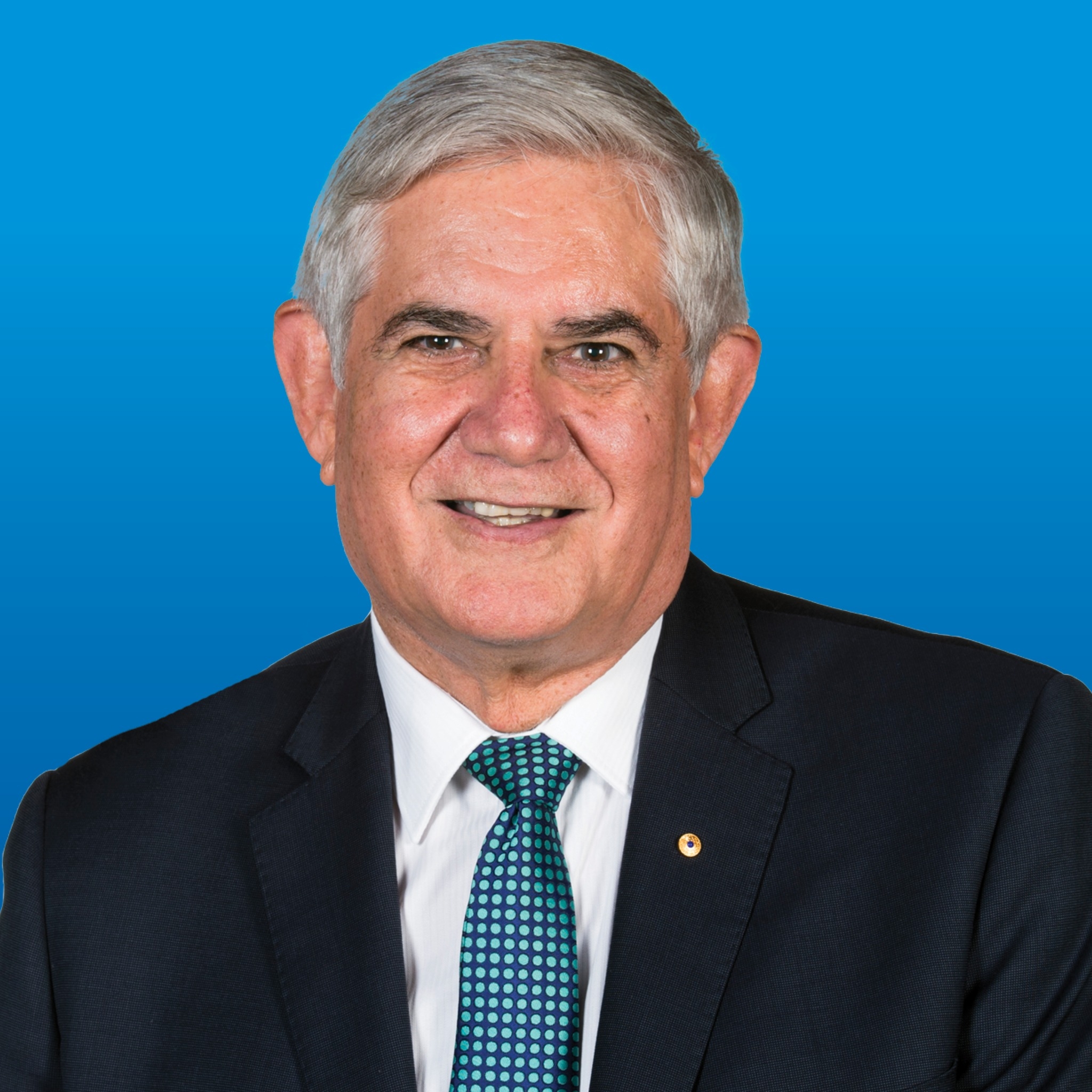
In other news we welcomed The Hon Ken Wyatt AM to RAA’s board in September. Ken was the first Indigenous Australian elected to the House of Representatives, the first to serve as a government minister, and the first appointed to cabinet. Before entering politics, he had an extensive career in health, education, Aboriginal Affairs and Aboriginal Land issues. Ken brings a wealth of knowledge and a unique perspective to the board of Rock Art Australia. Read more about Ken Wyatt here.
As 2023 ends, I would like to sincerely thank you from all of us at RAA, for your ongoing support, generosity, and commitment so this important and impactful research can continue, and the benefits and stories shared with the people of Australia.
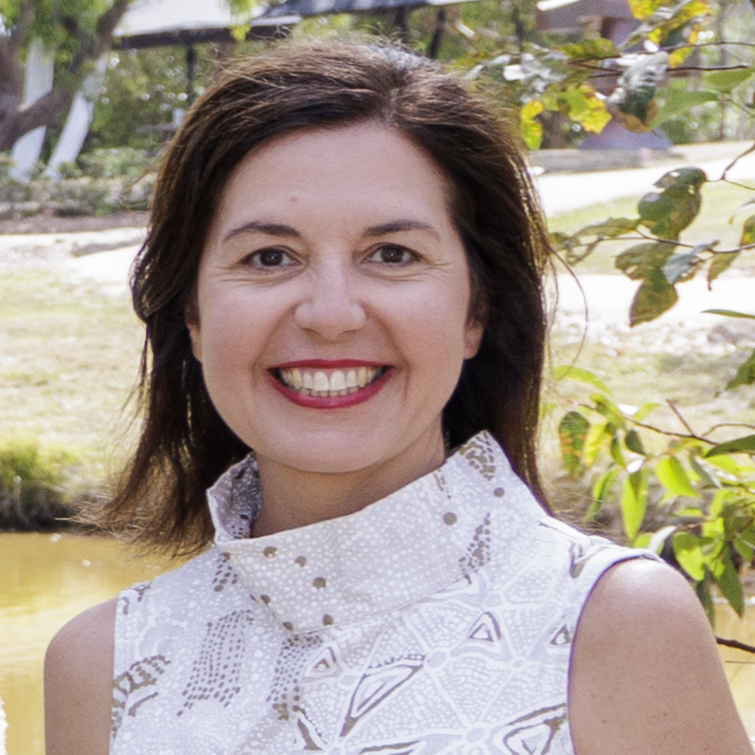

Samantha Hamilton
CEO I Rock Art Australia
RESEARCH ENGAGEMENT
Community engagement in the Kimberley

Liz Vaughan RAA Director of Partnerships & Research travelling from the KLC AGM at Home Valley Station on the Gibb River Road in September
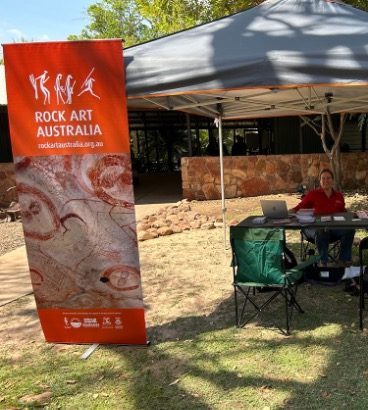
Liz Vaughan at the RAA information stall at the KLC AGM at Home Valley Station
Over the last 3 months, Liz Vaughan RAA’s new Director of Partnerships & Research spent time travelling around the Kimberley meeting with Aboriginal organisations and people in Broome, Derby, Mowanjum, Kununurra and Wyndham. Liz was invited to attend meetings of Kimberley Aboriginal Corporations and Prescribed Body Corporates (PBCs). These meetings have included the Kimberley Land Council (KLC) AGM and the Wanjina‐Wunggurr (Native Title) PBC AGM. Liz was able to sit, listen and talk about the needs, ideas, and views of the Kimberley people, many from Aboriginal groups with whom RAA works or would like to work with. Liz also explained and promoted RAA’s research priorities and funding support to investigate, document and protect rock art through both Aboriginal knowledge and scientific research.
LECTURES AND EVENTS
Meet the Scientists at the Archaeological Science Laboratory, University of Melbourne
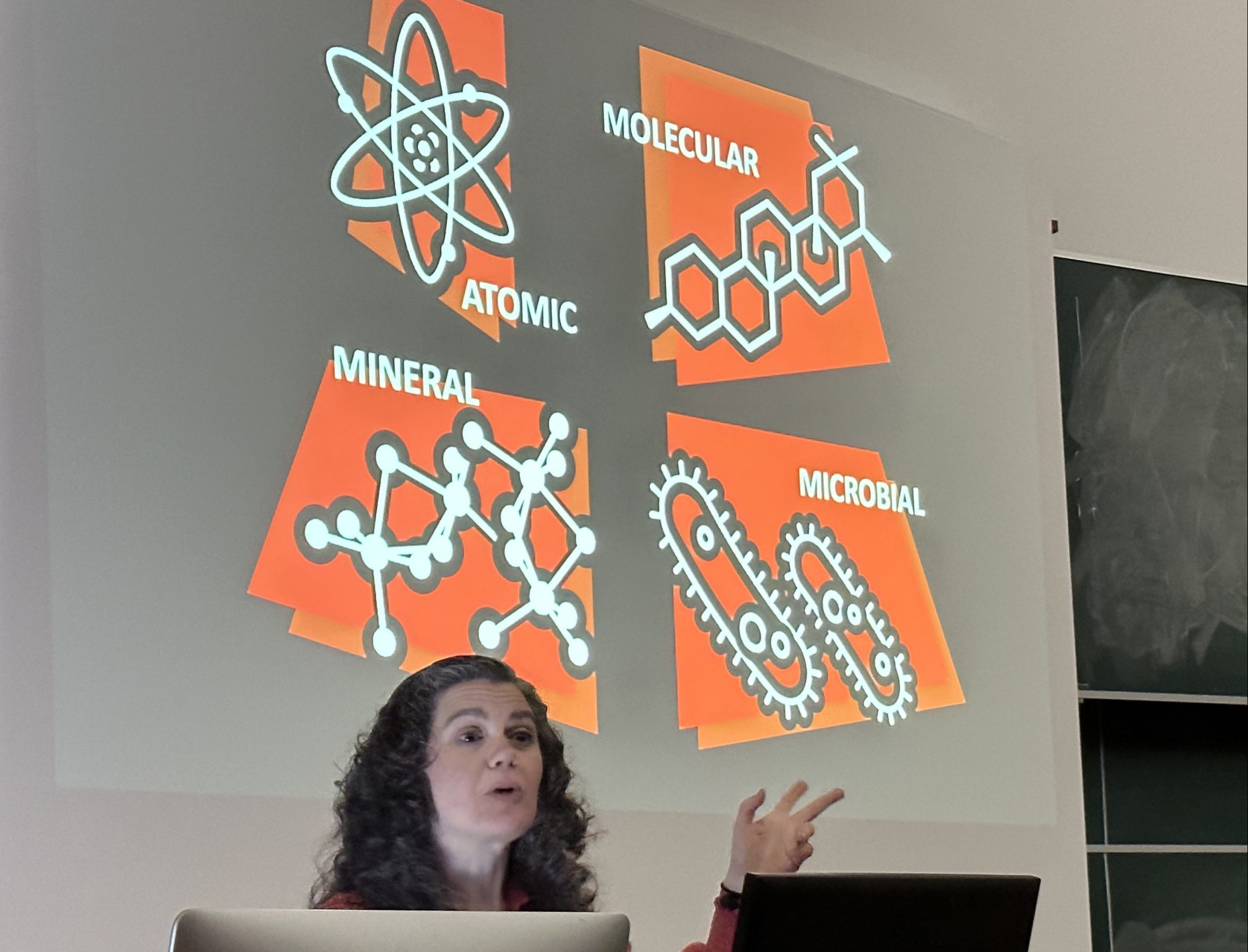
Professor Rachel Popelka-Filcoff presenting on the key research areas on archaeological pigments
In early October RAA hosted a ‘Meet the Scientists’ event at the Archaeological Science Laboratory at the University of Melbourne. The event started with presentations by RAA Minderoo Chair in Archaeological Science Professor Rachel Popelka-Filcoff and Senior Fellow in Archaeological Science Dr Louise Shewan, in the historic Masson Theatre in the Chemistry Building. Rachel shared insights about her research involving the characterisation and provenance of ochre pigments as well as her recent work on the non-destructive analysis of Kimberley rock art pigments in collaboration with Kwini traditional owners. Louise spoke about her research including the 3D visualisation of Kimberley rock art shelters. She explained how the creation of high-resolution 3D digital models of the rock art can be used a powerful tool for dissemination and engagement as well as a resource to aid conservation measures and to enhance research and educational offerings.
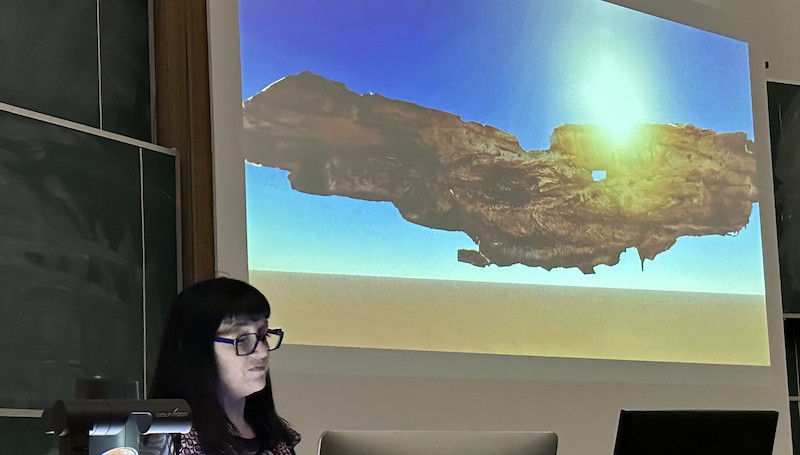
Dr Louise Shewan sharing 3D visualisations of rock art shelters in the Kimberley
Following the presentation, attendees were treated to behind-the-scenes tours of the Archaeological Science Laboratory and TrACEES laboratories. The attendees witnessed demonstrations conducted by lab members Professor Rachel Popelka-Filcoff, Dr Venera May, Dr Charles Croft, Maddison Crombie, and Noa Abraham. They learnt about how pyrolysis gas chromatography mass spectrometry is used to understand what happens to different pigment-binder mixtures as they age. Attendees also learnt about non-destructive reflective spectroscopic colour analysis of ochre pigments using different spectrometers and about the experimental results from pigment heating and synchrotron studies. Overall, this scientific analysis helps inform the provenance and exchange of ochre, rock art composition and long-term preservation of the art.
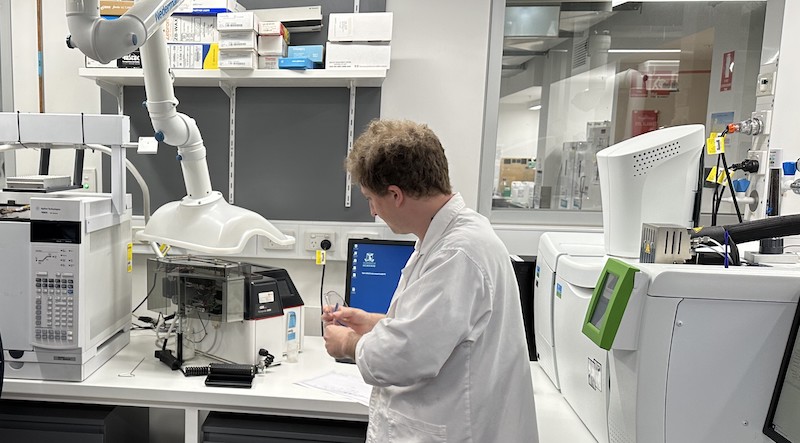
Attendees learnt about pyrolysis gas chromatography mass spectrometry from Dr Charles Croft
Humans in Pleistocene Wallacea
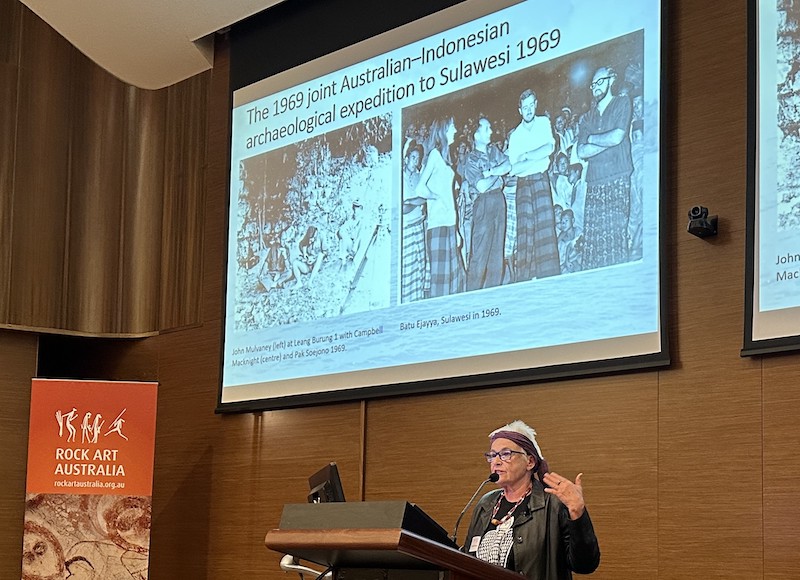
Professor Sue O’Connor presenting at the UWA Club in October 2023
Later in October Professor Sue O’Connor from the ANU College of Asia and the Pacific captivated audiences in Perth with a lecture about her considerable body of work in Wallacea. Sue shared research about the earliest evidence of human settlement and potential pathways through Wallacea. She explained how thousands of years ago, when the sea-level was much lower than today, many Southeast Asian islands were connected in an ancient continent known as Sunda. Sue spoke of the transitional biogeographic zone of Wallacea to the southeast of Sunda, a chain of islands that are unique in the region because they were never connected to their neighbouring continents of Sunda or Sahul. Sahul was the ancient super-continent of Australia and New Guinea, and was inhabited by humans thousands of years ago. Particularly fascinating were the examples of excavated fishing hook technologies made from shell which provide a glimpse into subsistence practices of early humans neighbouring Australia to the north.
Landscape and Time: Celebrating a decade of Rock Art Dating

Professor Andy Gleadow presenting the annual public lecture in Melbourne
In November we presented our annual public lecture at the University of Melbourne, which was presented by Professor Andy Gleadow. Andy shared a snapshot of a decade’s worth of incredibly rich and diverse research from the Kimberley Rock Art Dating project. This project involved working in partnership with Traditional Owners, community members and the Balanggarra Aboriginal Corporation. The lecture provided insights into a vast body of knowledge including understanding the rates of landscape evolution, rock shelter formation mechanisms and life cycles, the comprehensive documentation of rock art sites, sampling protocols with minimal impact, cosmogenic radionuclide dating of rock art slab falls, Uranium-Thorium dating of mineral accretion layers on top of the rock art, and radiocarbon dating of more than 500 mud wasp nests to be able to date the rock art. This incredible body of knowledge will enable the scientists and Aboriginal community members to develop further research which will focus on the preservation and conservation of rock art and sites.
‘Two ways to see’ book launch
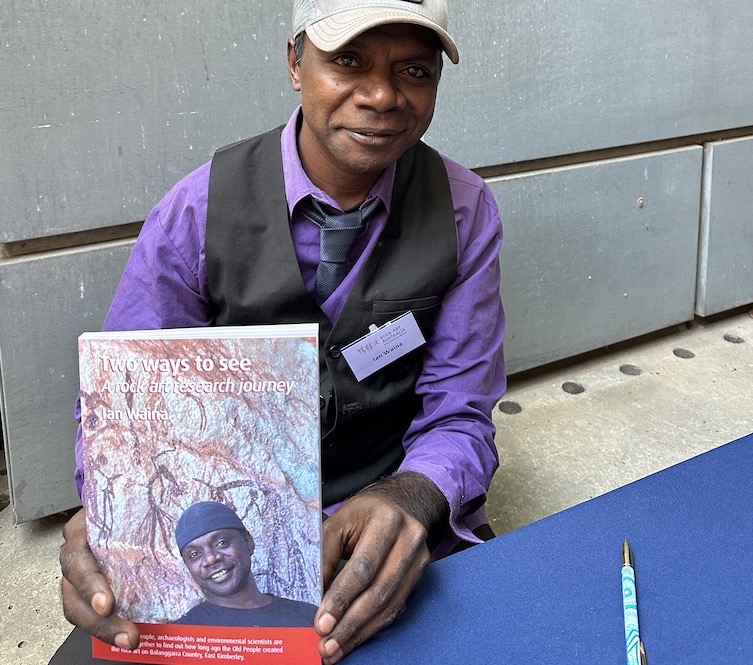
Ian Waina at his book launch in Melbourne in November 2023
We also enjoyed launching Ian Waina’s ‘Two ways to see’ book in Melbourne. Ian is a Kwini Traditional Owner, who lives in the remote community of Kalumburu in Western Australia and has worked with many scientists over the past 10 years. Ian had the vision to write this book to share with the ‘world’ how the traditional owners have worked together with scientists over the past decade to document, understand and protect significant rock art sites. Ian says:
“I think bringing my cultural knowledge and scientific ways together helps answer some of the questions we have about the rock art and our history. It’s seeing it both ways, the scientific way and Aboriginal way. When I was still at school, I started taking people to visit the rock art sites. The big question the tourists would ask was how old is the rock art? To tell the truth I didn’t know. I would answer them with its older than me and you. I really wanted to find the answer to that question. I am grateful for working with the researchers for many years. We have asked many questions and found many answers but there are still many more to come. I hope that we find older and older dates. I am very proud to share these stories, to pass this knowledge to the next generation. I hope they will carry this work on with traditional owners, new scientists, and technologies to keep discovering two ways to see. I believe these two ways to see is important not only for my people but for the rest of the world. I was really proud to launch my book, I travelled from my hometown of Kalumburu in the Kimberley to Melbourne to do so”.
This book and the two-way knowledge research will be shared through the ‘Two ways to see’ lecture series presented by Ian and Professor Andy Gleadow, in all capital cities of Australia in 2024. We will promote the lecture dates and locations through our website and social media in the new year. The book will be on sale at these lectures and can also be purchased by contacting RAA at hello@rockartaustralia.org.au
Science Advisory Council’s (SAC) 18th Annual Research Workshop
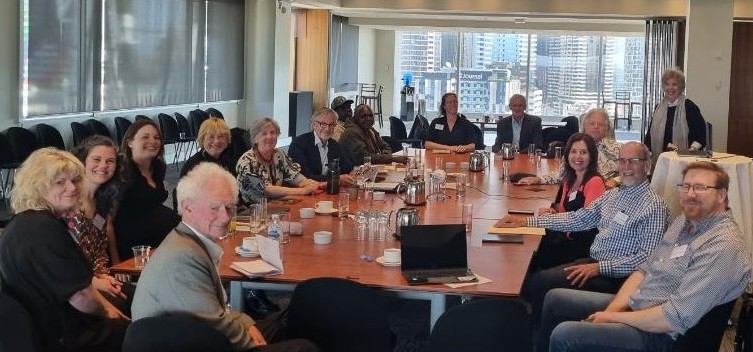
RAA Board and Management team, SAC members and Traditional Owners at the SAC 18th Annual Research Workshop
November also saw the delivery of our Science Advisory Council’s (SAC) 18th Annual Research Workshop. Described as the highlight of the year by the researchers, this workshop brought together members of the Science Advisory Council and others to share ideas, fieldwork, and discoveries from the past 12 months. We also had the pleasure of hosting Traditional Owners Robyn Mungulu and Graham Woolagoodjah from Dambimangari and Ian and Bernadette Waina from Balanggarra Country to continue to enable future partnership research priorities. Presentations shared information about the paleoenvironment in the Kimberley including understanding more about when it was dry and when it was wet, evidence of plants within the existing rainforests, what the climate was like when people migrated to the Kimberly, and the land mass that used to connect the Kimberley to Arnhem Land. This research included scientific investigations using geomorphic modelling and 3D scanning and modeling. Other presentations shared how archaeological researchers are working with Aboriginal communities to support the intergenerational knowledge transfer of rock art, documenting the links between Aboriginal communities and landscapes from the desert to the sea, and the benefits of Aboriginal community members having time on country to work with researchers, including rock art ranger training programs. We certainly look forward to sharing the development and publication of this research in time.
Wulk (Red Lilly Lagoon) on the Manilakarr Clan Estate, Western Arnhem Land
One of the research presentations at the Science Advisory Council’s (SAC) 18th annual research workshop was from Professor Chris Clarkson from the University of Queensland. Chris has worked in partnership with Dr Tristen Jones from the University of Sydney and Kasih Norman from Griffith University, to perform preliminary research, which builds on decades of archaeological and rock art work, around the escarpment edge of East Alligator and Red Lilly Lagoon in the Meikinj Valley in West Arnhem Land. The team are working closely with the Nayinggul family, Njanmaja Rangers and Manilakarr clan to build a large collaborative community directed research project involving rock art recording, dating and conservation, archeological survey, coring, and excavation, oral history documentation, and future impacts of climate and sea level change to identify and document heritage at risk. The sites surveyed in 2022-23 included Indjanjdjawarr, Wulk and Arawala and findings and outcomes include that Wullk has enormous potential for new rock art, archaeological and paleoenvironmental research and ten sites have been proposed to begin test coring. The team will continue working on the next steps of the project in collaboration with the community, so stay tuned for further updates.
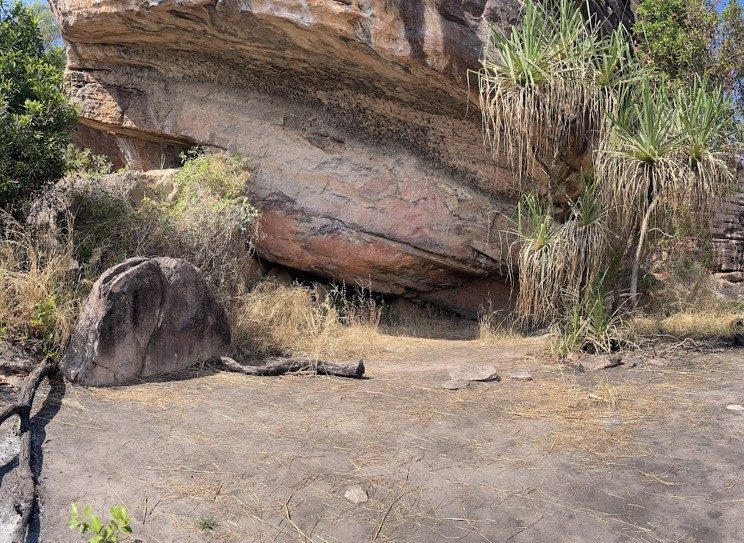
Survey of the Indjmandawarp site
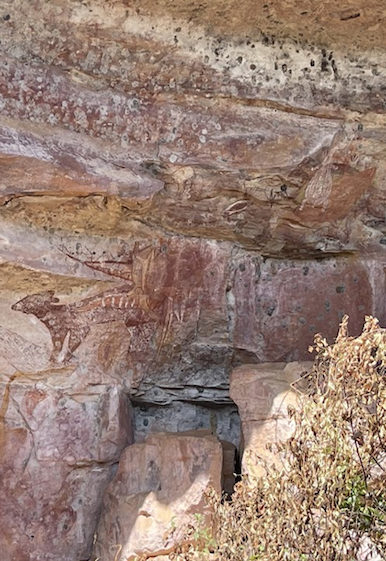
Image of rock art at the Indjmandawarp site
PROJECT UPDATE
Chaloupka Archive digitisation project
RAA TO SPONSOR INTERNATIONAL CONFERENCE ON ARCHAEOLOGICAL SCIENCE
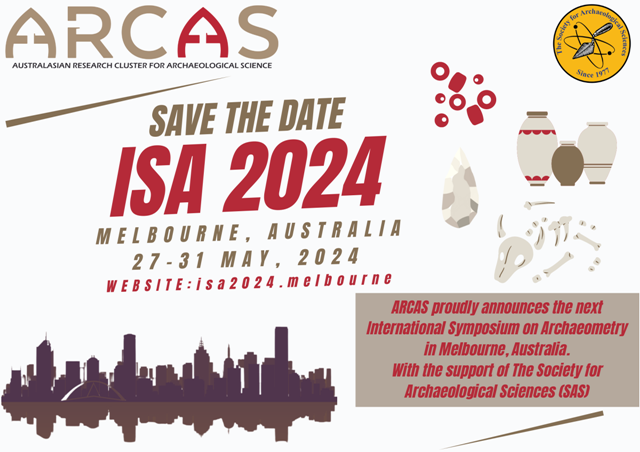
Rock Art Australia is the Platinum Sponsor for the prestigious 2024 International Symposium on Archaeometry (ISA), the leading international conference of archaeometry and archaeological science. It is the first time it will be held in Australia, with over 200 international researchers expected to attend. It holds the mantle for being the foremost global conference dedicated to archaeometry and archaeological science. The RAA Minderoo Chair in Archaeological Science, Prof Rachel Popelka-Filcoff is leading this pioneering symposium, to be held at The University of Melbourne in May 2024.

RAA ADDRESS UPDATE
Level 6, 41 Exhibition Street, Melbourne, VIC 3000
Our contact details and telephone numbers remain unchanged.
We gratefully acknowledge the generosity of our leading donors.
DONATE NOW and help us fund the ‘Two ways to see’: A rock art research journey national lecture series
In 2024 Rock Art Australia will present the ‘Two ways to see’: A rock art research journey national lecture series across Australian capital cities.
This lecture series will raise public awareness by sharing how traditional owners and scientists have worked together to find out how long ago the Old People created the rock art on Balanggarra Country, East Kimberley.



